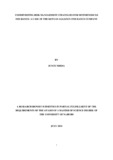| dc.description.abstract | In recent years, risk management has been the subject of financial scrutiny due to the financial crises of 2002 and 2007. The Ukrainian and Greek case have also highlighted great weaknesses in financial risk management. Despite the existence of risk management policies and strategies, it is seen that implementation of these strategies is still an uphill task. The insurance industry, which is also part of the finance industry, has not been spared in terms of their existing risk management strategies.
The United Kingdom and India are seen as market leaders in the insurance industry. These market leaders have employed various risk management strategies. The United Kingdom uses the Solvency II model of risk management, which considers reserving, capital adequacy requirements and pricing of insurance products. India employs risk modeling among others as their risk management strategies.
The Kenyan insurance industry is unique in terms of dealing with underwriting risk. Rate pricing and rate reserving are used as opposed to risk related pricing and reserving strategies. Risk modeling is rarely used in computation of aggregate claims. The main objective of the study was to apply risk modeling as a risk management strategy in the Kenyan insurance industry.
The study relied on secondary data obtained from The Kenyan Alliance Insurance Company Limited. The data reviewed was motor vehicle claims data for 2010. Exploratory statistical tests were carried out before modelling the number of claims and the claims severity. Aggregate claims were then determined by use of the collective risk model. Expected premiums for year 2011 we obtained using the expected value principle, standard deviation principle and credibility premium.
The study found that the expected premiums were much higher than the rate computed premiums. The result suggests that for the same amount of claims that an underwriter has to pay, the premium charged should be higher. | en_US |


